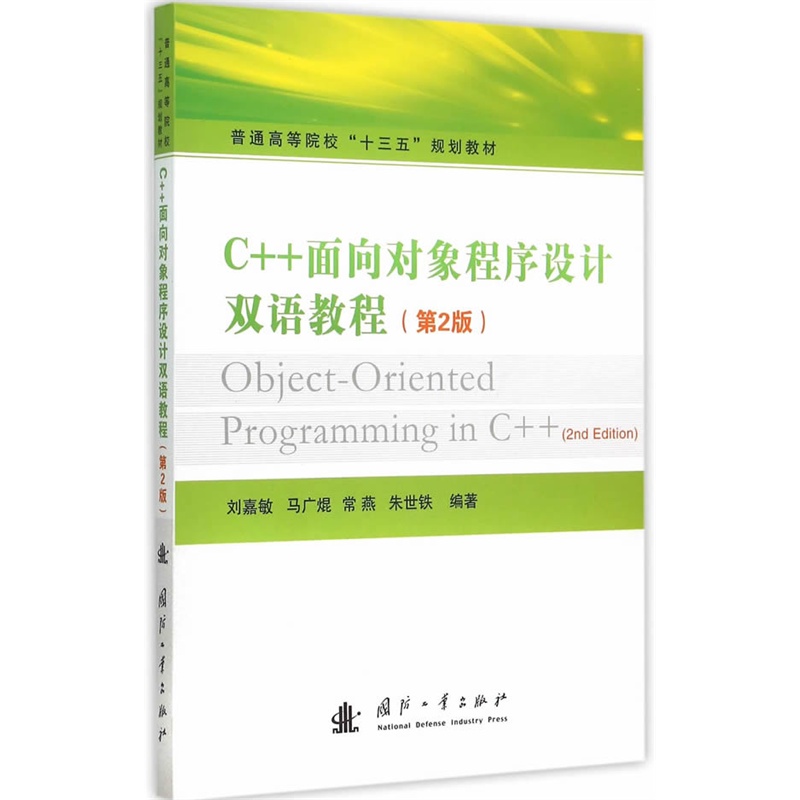
包邮C++面向对象程序设计双语教程-(第2版)

- ISBN:9787118103656
- 装帧:一般胶版纸
- 册数:暂无
- 重量:暂无
- 开本:16开
- 页数:275
- 出版时间:2015-08-01
- 条形码:9787118103656 ; 978-7-118-10365-6
本书特色
由刘嘉敏、马广焜、常燕、朱世铁编著的《c++ 面向对象程序设计双语教程(第2版普通高等院校十三五规划教材)》从面向对象程序设计的特点出发,分章节循序渐进地介绍了面向对象的相关概念及运用c ++实现的过程,并辅以大量程序清单。同时书中在各个章节起始处明确了章节学习目标,且在全书中重要知识点处均有提示,各章末尾有本章出现的重要的词汇注解和本章相应的练习题,有助于读者理解书中内容,帮助读者掌握面向对象编程方法。全书共分8章, 具体内容包括:导论、基本工具、类和对象(1)、类和对象(2)、运算符重载、继承、多态性和虚函数、模板。
内容简介
本书从面向对象程序设计的特点出发,分章节循序渐进地介绍了面向对象的相关概念及运用C++实现的过程,并辅以大量程序清单。同时书中在各个章节起始处明确了章节学习目标,且在全书中重要知识点处均有提示,各章末尾有本章出现的重要的词汇注解和本章相应的练习题,有助于读者理解书中内容,帮助读者掌握面向对象编程方法。 全书共分8章,具体内容包括:导论、基本工具、类和对象(1)、类和对象(2)、运算符重载、继承、多态性和虚函数、模板。
目录
-

大模型应用开发极简入门 基于GPT-4和ChatGPT
¥41.9¥59.8 -

这就是ChatGPT
¥41.9¥59.8 -

电脑组装、选购、操作、维护、维修从入门到精通
¥32.2¥48.0 -

数据结构教程(第6版·微课视频·题库版)
¥46.5¥65.0 -

计算机组成原理实验指导与习题解析
¥34.8¥52.0 -

微信小程序开发教程
¥31.4¥49.0 -

机器学习
¥47.4¥108.0 -

C程序设计(第五版)
¥18.6¥49.0 -

深度学习导论
¥24.5¥49.0 -

有限与无限的游戏:一个哲学家眼中的竞技世界
¥36.4¥68.0 -

RFID与智能卡技术实验指导书
¥28.4¥36.0 -

UNITY游戏开发经典实例
¥73.0¥128.0 -

软件开发技术基础 第4版
¥65.7¥79.9 -

软件测试
¥50.0¥68.0 -

AIGC文图学 人类3.0时代的生产力
¥36.0¥48.0 -

AFter Effects 影视后期特效实战教程
¥45.0¥69.8 -

生物特征识别算法研究
¥20.1¥39.0 -

大模型应用开发动手做AIAGENT
¥62.9¥89.8 -

游戏造物主;游戏与制作人的幕后故事
¥63.6¥108.0 -

python语言程序设计(第2版)(含视频教学)
¥50.6¥69.9











